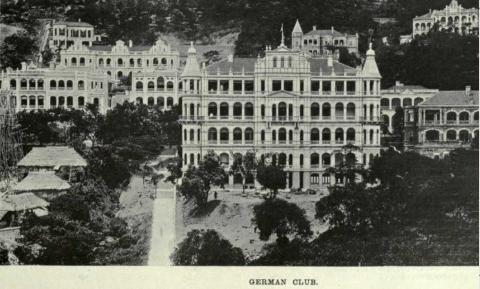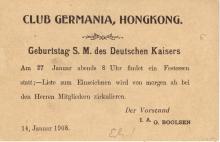Current condition
Demolished / No longer exists
Date completed
Date closed / demolished
This view is the rear, which faces downhill from Kennedy Road.
The club moved here from the previous site on Wyndham Street in 1902.
Confiscated during WWI as enemy (German) property, it was bought by St. Joseph's College. Two other buildings were built in the 1920s, downhill from the old Club building.
In 1962, the old Club building was torn down and replaced by the "New Building" of St. Joseph's College.




Comments
The new clubhouse was opened…
The new clubhouse was opened at midday on 31 Dec 1902. The opening was reported on page 5 of that day's China Mail:
THE GERMAN CLUB.
Opening of New Premises.
The opening of the new German Club premises at Kennedy Road to-day may be taken as satisfactory evidence that our friends of the German community are prospering. For many years, they have occupied the building in Wyndham Street near this office, but the changed conditions in the centre of the town, together with the steady increase in membership, made a new situation almost a necessity, and the members may be congratulated on the palatial and handsome clubhouse they have erected for themselves. It is situated on the north side of Kennedy Road, near the Union Church, and the site embraces the whole of the ground from the roadway down to the nullah and tramway station. These grounds can be laid out effectively as ornamental gardens and tennis lawns.
The site is a very sloping one, which has involved difficulties for the architects, but all the difficulties have been overcome successfully. The clubhouse is built in five storeys, and the architects have adopted a free treatment of the English rennaisance in their design, the effect being extremely pleasing when viewed from a favourable coign of vantage. In the basement or lower storey are the bowling alleys, four in number, with bar and lavatory attached. Above this is the reading room, library, and secretary's and steward’s rooms. The bar and billiard rooms are on the principal floor, with the main entrance from Kennedy Road. On either side of the entrance lobby are the telephone and porter’s rooms. The billiard room will contain six tables. The fourth floor contains the big dining room, which is so arranged that part of it can be divided off by sliding doors so that it can be utilised as a stage for private theatricals and concerts or for private dinner parties. There is also on this floor a large ante-room and drawing and card room, and all the usual accessories for the kitchen and serving rooms. The dining room is 88 feet long and 30 feet wide. The upper floor contains eleven bed-rooms, conveniently arranged with bath-rooms and sanitary arrangements.
Along the whole front of the building there is a fine wide verandah, with pointed turrets at each corner, and projecting balconies round the turrets and in the centre gable. The two lower storeys are rusticated. The whole of the staircases and mantelpieces, the bar fittings and the floors of the principal rooms are of teak, and the staircase has been arranged to take a lift. Etectric bells are fitted throughout the building, which is lit by gas with incandescent burners.
Access can be obtained to the clubhouse from the new roadway which debouches from Garden Road at the lower tramway station, skirts the Club site and connects with Kennedy Road.
The Club house is an attractive addition to the architecture of the Colony, and is in every way a credit to the designers, Messrs Denison, Ram and Gibbs, who have also supervised the construction. Wing On was the contractor.
At twelve o’clock, the members of the Club assembled in the new Clubhouse for the private and formal opening of the new premises. There were also present H. E. Vice-Admiral Geissler and Lady Geissler, the German Consul, and all the naval officers who could be spared from the ships in harbour. Mr G. Harling, President of the Club, proposed the health of ‘The Emperor,’ which was pledged in loyal bumpers. Mr Harling then made a long speech reviewing the history of the Club Germania in Hongkong. It was now forty-two years old, he said, and was originally housed at Wanchai in what is now the hospital for the soldier’s wives and children. the Club was now in a prosperous condition, with more members than it ever had before. He concluded by calling upon those present to drink ‘Success to the Club Germania.' The toast was drunk enthusiastically, and the black, white and red ensign was hoisted on the flagstaff.
Admiral Geissler then made a short speech, taking the opportunity to thank the members for their generous hospitality to the officers of the German warships on this Station. He wished the Club every success and continued prosperity.
Mr Paul Brewitt, Hon. Secretary, proposed the health of the architects, coupled with the name of Mr E. A. Ram, who responded briefly.
During the proceedings, Mr Harling presented Mr Brewitt with a handsome gold watch bearing the following inscription:- 'Presented to Mr Paul Brewitt, in thankful recognition of his long and valuable services to the Club Germania, by the members. Hongkong, December 31, 1902.’
The visitors then inspected the new premises, and Mr C. E. LeMunyon took a photographic group of the members at the Kennedy Road entrance.
Re: St. Joseph's College at Kennedy Road
St. Joseph's College at Kennedy Road comprised the following buildings:
(1) Club Germania building that was purchased in 1918. In 1961, the old building was demolished and a new wing (seven-storey South Block) was erected in 1963;
(2) North Block (with its distinctive two towers) that was opened on 5 September 1921. Now known as the "Old Building";
(3) West Block (Chapel Hall) that was opened on 24 October 1925 to provide a connecting link between the North Block and the former Club Germania building. Now known as the "Old Hall";
Both the North and West Blocks were declared monuments in 2000.
(4) Annex at 26 Kennedy Road, a Grade 1 Historical Building that was acquired from Government and opened in 2018.
Sources:
a) Hong Kong Lasillian Story at: https://mission.catholic.org.hk/wp-content/uploads/2019/02/The-Hong-Kon…
b) North Block and West Block at: http://202.85.100.78/pages/heritage/sjc-b7.html
c) Antiquities & Monuments Office at: https://www.amo.gov.hk/en/historic-buildings/monuments/hong-kong-island…